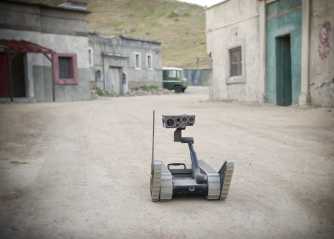"Anybody home?" An iRobot Small Unmanned Ground Vehicle peers into a front door in this war game, alerting its operator, far left, to what's inside via video.
Ready or not, robot wars are coming.
That was made clear in the skies over Pakistan a week ago, when an unmanned drone killed al-Qaeda’s No. 2 leader with a missile strike. And it’s happening on the ground in Afghanistan, where robots are increasingly doing the dirty and dangerous work – exploring caves and “walking the point” ahead of their squad — long done by grunts.
“Before our PackBots got into service, the Army and Marine Corps’ technology to do cave reconnaissance was a 19-year old soldier with a 12-foot stick, and a rope around his waist to pull him back if he got hurt,” says Joe Dyer, the chief strategic officer of iRobot (yep, the same folks who make the Roomba home vacuum cleaner). Now small robots perform that dangerous mission.
(MORE: Soldiers Command Roomba Maker’s New Military Robot with Xbox Controller)
“This has given our warfighters tremendous capability,” said Zachary Lemnios, a top Pentagon engineer. “It’s kept young kids out of the fight where they can operate this tele-operated vehicle to clear a room, to clear a building, to provide initial insight into very dangerous areas. And quite simply, it saves lives.”

iRobot
So why not expand the envelope? The Army says more than half their casualties come on “first contact” with the enemy. “That’s why the point-man position is so damn popular,” Dyer says, sarcastically. “The Army is beginning to believe – and certainly iRobot believes – that’s a great job for a robot.”
While there isn’t yet a robot walking ahead of troops on their 10-mile patrol, they are doing short-range assignments on such missions, checking out what lies around the corner up ahead or in a building in need of searching. As the robots become better — smarter – it seems only a matter of time before the man walking the point is a machine.
OK, all you sci-fi futurists unnerved by the prospects of a Pentagon robot-led coup can rest easy: “We don’t see robots taking over,” says Dyer, a former Navy test pilot and retired vice admiral, leaving himself just the tiniest bit of wiggle room. But the world is, he believes, on the cusp of a robot revolution: “I believe there will be manned aircraft, with unmanned wingmen, and infantry soldiers that are supported by unmanned ground robots.”
Ever the days of Jules Verne and Tom Swift, we’ve been reading of the automation of warfare. Why is this happening now? “Robots have been a promise for many years,” Dyer concedes. “The thing that’s made the real difference in bringing on the reality is Moore’s law” – that computing power doubles every 18 to 24 months – “and the fact that affordable processing power has finally caught up with the engineering.”
(MORE: Military Buys Tiny ‘FirstLook’ Droppable, Flipping Robots in Bulk)
The wars of the past decade also play a role. “It took 20 years for unmanned air vehicles to achieve a half-billion-dollar market because there was so much resistance” to them from inside the military, Dyer says. But “the Army’s embracing of unmanned systems has been faster, because it puts distance between clear and present danger and the troops.”
Ground-based robots have been hunting for IEDs and clearing houses and caves since shortly after 9/11. “It certainly contributed to survivability, and it traded on the fact that robots are fearless,” Dyer says. “We get postcards from theater that say `you saved lives today’ – it doesn’t get much better than that.” Some troops give their robots names, and mourn them when– despite their skills – they are lost in battle.
Two-thirds of iRobot’s revenues come from the home market: it has sold some 8 million vacuums and other robotic devices designed to scrub floors, cleaning swimming pools and degunkify gutters. It has sold only about 5,000 robots to military customers, including 800 now serving in war zones with U.S. troops. Just last week, the Army awarded iRobot a $12.7 million contract for 68 of the company’s 310 Small Unmanned Ground Vehicle robots, doubling its initial order of the troop-carried, IED-hunting ‘bot.
There are downsides to robo-warriors: the notion that a non-human force can kill without risk to its human masters is a notion worth pondering. “In the geo-political realm, that’s something that needs consideration,” Dyer says. But there are upsides, too: “This kind of technology-for-labor trade,” he predicts, “will allow us to do more with a smaller force.”


